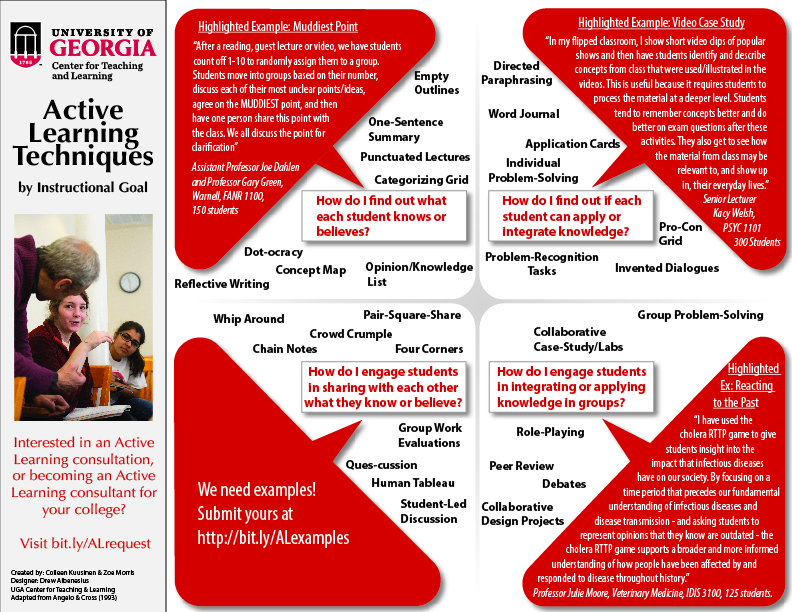Active Learning
Active learning is the adoption of instructional practices that engage students in the learning process (Prince, 2004). The instructor’s role is as expert guidethrough activities and situations in which the student must engage in thinking about the content toward the desired learning outcomes (Mayer, 2004). Active learning includes single-class and multiple-class activities to target specific instructional goals, yet it also includes pedagogical approaches and accompanying curriculum that integrates multiple instructional goals achieved through the design of the course.
Active learning promotes improved student attitudes, as well as better writing and critical thinking skills
(Baepler, Walker, & Driessen, 2014; Bernstein & Greenhoot, 2014; Bonwell & Eison,
1991; Freeman et al., 2014), higher examination performance (Freeman et al., 2014; Gingerich et al., 2014; Ruhl, Hughes, & Schloss, 1987), lower failure rates (Baepler et al., 2014; Reinholz, 2015), improved conceptual understanding of basic concepts and surfacing of misconceptions in the sciences (Hake, 1998; Redish, Saul, & Steinberg, 1997).
What is it NOT?
Active learning is NOT just about students being physically active and moving around in the classroom. It’s about activity in the brain—providing opportunities during class for students to start thinking about the material, discussing their thinking with others, testing out ideas and strategies with feedback from the instructor and peers—before the final exam (Gingerich et al., 2014).
Active learning is NOT something you can only do in certain spaces. Active learning can be incorporated into traditional large lecture halls. See the “Muddiest Point” example below from Gary Green to see how a large lecture hall can become an active learning space for 10 minutes. It is true, however, that flexible learning environments are less constraining than traditional lecture halls (Baepler, 2014).
Active learning does NOT make the instructor irrelevant. Quite the contrary! The instructor becomes MORE important in an active learning classroom because their expertise is needed to design meaningful activities, guide students as they work through course material, interact with students, and facilitate reflection on what was learned. As the instructor gathers formative assessment data through these different activities, they gain insight into how students understand the material enabling them to generate new learning experiences that will help students clear up misconceptions or misunderstandings before summative assessments (Bonwell & Eison, 1991; Mayer, 2004). Faculty are also critical in helping minimize student resistance, discomfort and uncertainty about the purposes of active learning strategies. Watch Kimberly Tanner, a biologist at San Francisco State University, explain how she alleviates student apprehension in large lecture halls when doing a "Think-Pair-Share."
Which activities are best for my goals?
To assist you in choosing the right activity, the chart below is organized by types of questions you might have about your classroom. Activities that allow each student to individually engage with the content are separated onto the top half; activities that require students to work in groups or share their thinking with their peers is on the bottom half. Activities were chosen from Angelo & Cross (1993) and other research-based practices (e.g., Van Amburgh, et al., 2007). These active learning strategies can be incorporated into most classrooms regardless of size.
Follow this link (PDF) to download an interactive version of this chart. Click on each activity name to see a brief description and example of its use in a UGA classroom. (PDF)

References
Angelo, T. A., & Cross, K. P. (1993). Classroom assessment techniques : a handbook for college teachers. San Francisco : Jossey-Bass Publishers, c1993.
Baepler, P., Walker, J. D., & Driessen, M. (2014). It’s not about seat time: Blending, flipping, and efficiency in active learning classrooms. Computers & Education, 78, 227–236. https://doi.org/10.1016/j.compedu.2014.06.006
Bernstein, D., & Greenhoot, A. F. (2014). Team-Designed Improvement of Writing and Critical Thinking in Large Undergraduate Courses. Teaching & Learning Inquiry, 2(1), 39–61. https://doi.org/10.2979/teachlearninqu.2.1.39
Bonwell, C. C., & Eison, J. A. (1991). Active Learning: Creating Excitement in the Classroom. ASHE ERIC Higher Education Report No. 1: The George Washington University, Washington, DC.
Freeman, S., Eddy, S. L., McDonough, M., Smith, M. K., Okoroafor, N., Jordt, H., & Wenderoth, M. P. (2014). Active learning increases student performance in science, engineering, and mathematics. Proceedings of the National Academy of Sciences of the United States of America, 111(23), 8410–8415. https://doi.org/10.1073/pnas.1319030111
Gingerich, K. J., Bugg, J. M., Doe, S. R., Rowland, C. A., Richards, T. L., Tompkins, S. A., & McDaniel, M. A. (2014). Active Processing via Write-to-Learn Assignments: Learning and Retention Benefits in Introductory Psychology. Teaching of Psychology, 41(4), 303–308. https://doi.org/10.1177/0098628314549701
Hake, R. R. (1998). Interactive-engagement versus traditional methods: A six-thousand-student survey of mechanics test data for introductory physics courses. American Journal of Physics, 66(1), 64–74.
Mayer, R. E. (2004). Should there be a three-strikes rule against pure discovery learning? The case for guided methods of instruction. The American Psychologist, 59(1), 14–19. https://doi.org/10.1037/0003-066X.59.1.14
Prince, M. (2004). Does Active Learning Work? A Review of the Research. Journal of Engineering Education, 93(3), 223–231. https://doi.org/10.1002/j.2168-9830.2004.tb00809.x
Redish, E. F., Saul, J. M., & Steinberg, R. N. (1997). On the Effectiveness of Active-Engagement Microcomputer-Based Laboratories: Part 1. American Journal of Physics, 65, 45–54.
Reinholz, D. L. (2015). Peer-Assisted Reflection: A Design-Based Intervention for Improving Success in Calculus. International Journal of Research in Undergraduate Mathematics Education, 1(2), 234–267. https://doi.org/10.1007/s40753-015-0005-y
Ruhl, K. L., Hughes, C. A., & Schloss, P. J. (1987). Using the pause procedure to enhance lecture recall. Teacher Education and Special Education, 10(1), 14–18. https://doi.org/10.1177/088840648701000103
Van Amburgh, J. A., Devlin, J. W., Kirwin, J. L., & Qualters, D. M. (2007). A Tool for Measuring Active Learning in the Classroom. American Journal of Pharmaceutical Education, 71(5).
